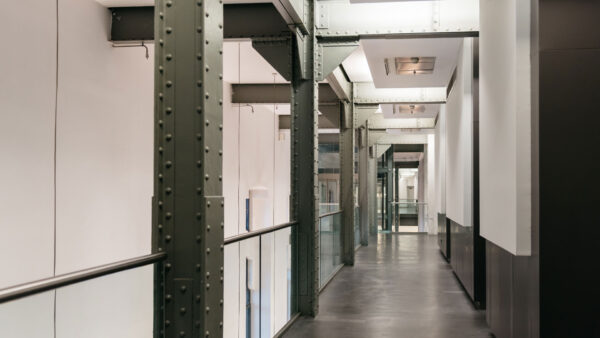Understanding the differences between engineering stress vs true stress is key for civil engineers designing steel structures.
While both measure a material’s response to forces, they have distinct definitions and applications.
This article explains the varying formulas, tensile test curves, and design uses of engineering vs true steel stress.
Difference Between Engineering and True Stress
Engineering stress uses the original cross-sectional area of a tensile test specimen to calculate stress as load divided by area (σ = F/A0).
This defines stress only up to the ultimate tensile strength point.
In contrast, true stress accounts for the decreasing cross-sectional region due to necking strains (εn). It uses the actual area at each strain level (A = A0(1 + εn)) when calculating true stress as σ = F/A.
Due to this fundamental difference in reference areas, true stress values exceed engineering stress for equivalent applied loads, especially after necking begins.
Comparing Engineering and True Stress Formulas
The engineering stress formula serves for basic material comparisons but does not represent realistic stress distributions within the necked region.
The true stress formula better indicates the intensifying stress levels within the shrinking area that actually lead to fracture failure.
The evolving true stress more accurately models deformation physics after the ultimate tensile strength when cross-sectional shrinkage localizes higher stresses.
Engineering stress meanwhile remains mathematically convenient for nominal comparisons before necking effects concentrate stresses.

Engineering Stress vs True Stress Curves
Stress-strain curves highlight the behavior divergence between engineering and true stresses.
Initially, both overlay since necking effects are minimal within elastic limits.
The curves separate after the ultimate tensile strength peak as engineering stress plateaus then drops as the specimen stops supporting additional load.
However, true strain increments and corresponding true stress progressively rise with the escalating strains until final fracture.
This reflects hardening plastic deformation concentrating within localized necking zones.
Why True Stress is Higher Than Engineering Stress
Necking causes the declining cross-sectional area which engineering stress ignores in its calculations, using only the constant initial area.
But true stress divides by this shrinking area.
For any given applied load then, higher true stresses result since the denominator area term is decreasing.
Localized necking indicates strained steel failing in that region first.
True stress captures the escalating stress levels within these necked zones accurately signaling impending fracture failure.
Effect of Necking on True Stress
Necking couples strain hardening and instability effects to concentrate deformation.
Hardening increases yield strength, requiring greater stresses for more plastic deformation.
But localized thinning then causes strain and true stress to intensify in this weakened region as continuity requires adjoining steel to equally deform.
This accumulates higher true strains and stresses, exhausting ductility limits precipitating cracks and ultimate fracture at the neck.

True stress quantifies this strain hardening and instability process dynamically escalating stresses within the necking zone.
Engineering Stress vs True Stress in Tensile Testing
Tensile tests apply controlled tension for generating entire engineering and true stress-strain curves up to failure.
Extensometers attached to sample gauge lengths directly measure elongation from which engineering strain calculates.
Initial cross-sectional area derives engineering stress.
Post-testing measurements on the necked region determine actual area for true stress computations.
While engineering values suffice for basic strength comparisons, true stress-strain data is necessary for detailed deformation modeling and fracture predictions.
Calculating True Stress from Cross Sectional Area
The fractured tensile specimen’s necked region has the minimum cross-section.
Precisely measuring this area (An) after failure along with the engineering stress curve allows calculating true stress at each strain level:
σtrue = σengineering (A0/An)
where A0 = original area before necking.
This back calculates true stress-strain values by accounting for the decreasing area which engineering stress misses.
Advantages of Using True Stress Measurement
The key benefit of true stress is quantifying intensifying stress levels within necked regions actually causing failure.
This data better inputs for numerical modeling of complex forming processes.
Using only engineering stress risks underestimating localized deformation stresses during metalworking and fracture likelihood.
True stress also allows accurately comparing differing steel chemistries’ full ductile capacities right up to fracture, whereas engineering values plateau after ultimate tensile points.
Relationship Between Engineering and True Stress Strain
Both stress definitions relate to sample instantaneous load levels.
Dividing by the same original area derives engineering stress and strain.

True stress accounts for evolving cross-section, reflecting this changing geometry dynamic in its computation.
A monotonic mathematical relationship links engineering to true quantities via continuously measured necking strains.
This physics-based interconnection models steel instability and hardening through fracture.
Using Engineering vs True Stress in Design Calculations
Engineering stress suffices for basic static steel member sizing well within elastic limits.
But true stress-strain data should input into computational simulations of force capacity near plasticity onset, estimating localized yielding and damage accumulation.
Likewise, true values inform fracture mechanics and crack growth models pernecking strain hardening behavior absent in engineering values.
Precision steel structure design balances strength, stability and ductility based on true stress-strain analysis.
Understanding these fundamental measurement differences between engineering stress vs true stress equips engineers to model steel behavior more realistically under diverse loading.
True stress-strain quantification underpins today’s advanced computational material modeling enhancing structural longevity and safety.
This covers the theoretical and practical distinctions between engineering approximations and physics-based true stress analysis for steel structural design.
Properly interpreted true stress-strain curves empower optimized material usage targeting safety along with sustainability.






